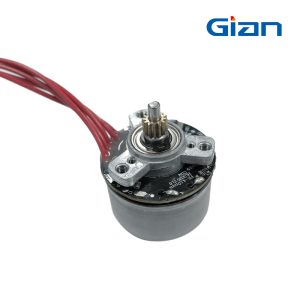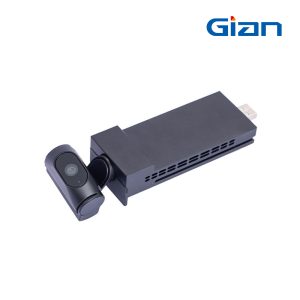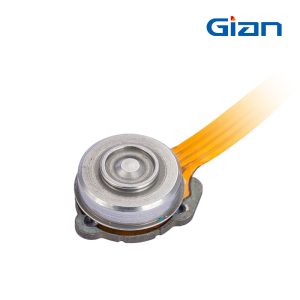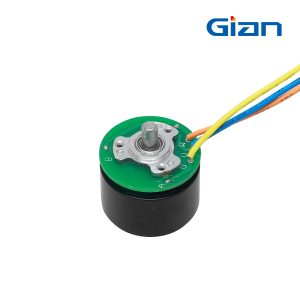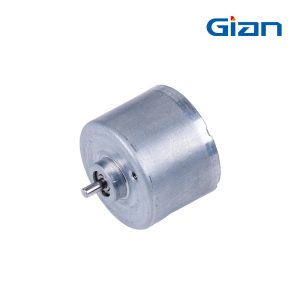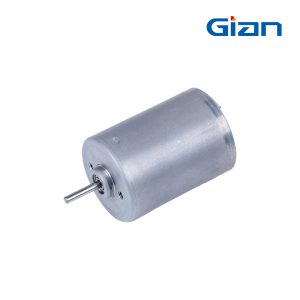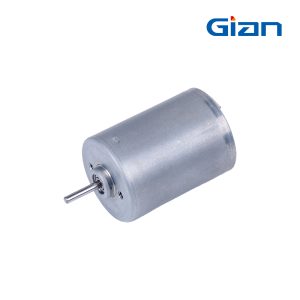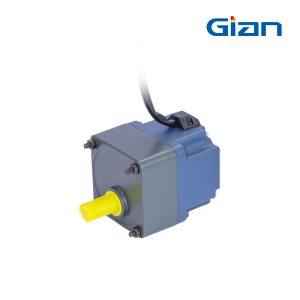What is an Outrunner Brushless Motor?
A brushless DC (BLDC) motor with the rotor on the outside and the stator inside is called an outrunner brushless motor. This design contrasts with traditional motors, where the rotor is typically inside the stator. The external rotor design allows for certain performance benefits, particularly in generating higher torque.
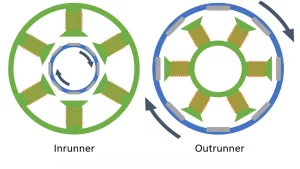
Key Components
- External Rotor: The rotor in an outrunner BLDC motor is located on the outside and typically features permanent magnets affixed to its inner surface. This external placement of the rotor is key to the motor’s ability to produce high torque.
- Internal Stator: The stator is positioned inside the rotor and holds the windings. When electrical current flows through these windings, it generates a magnetic field.
- Windings: These are coils of wire situated in the stator. They generate motion when current flows through them and combines with the rotor’s magnetic field to produce an electromagnetic field.
Working Principle
The operation of an outrunner brushless motor involves the following steps:
- Electric Current and Magnetic Field: When an electric current passes through the stator windings, it generates a rotating magnetic field.
- Interaction with Rotor Magnets: The permanent magnets on the interior surface of the external rotor are in contact with this rotating magnetic field.
- Torque Production: The torque produced by the interaction of the rotor magnets’ and stator windings’ magnetic fields causes the rotor to rotate.
- Continuous Rotation: The rotor continues to rotate as long as the stator windings are supplied with current, maintaining a rotating magnetic field that keeps the rotor in motion.
Pros and Cons
Pros | Cons |
|
|
Featured Products
What is an Inrunner Brushless Motor?
An example of a brushless DC (BLDC) motor with a rotor housed inside the stator is an inrunner BLDC motor. This conventional design contrasts with the outrunner motor, where the rotor is external. Inrunner motors are known for their ability to achieve high rotational speeds and are often used in applications where compactness and high RPMs are essential.
Working Principle
The operation of an inrunner brushless motor involves the following steps:
- Electric Current and Magnetic Field: A revolving magnetic field is produced by an electric current passing through the stator windings.
- Interaction with Rotor Magnets: This rotating magnetic field interacts with the permanent magnets on the rotor’s surface.
- Torque Production: The interaction of the electromagnetic fields of the stator and rotor produces torque, which causes the rotor to rotate.
- Continuous Rotation: As long as the stator windings are supplied with current, the rotating magnetic field is maintained, and the rotor continues to spin, producing continuous motion.
Key Components
- Internal Rotor: The rotor is located inside the stator and contains permanent magnets on its outer surface. The compact placement of the rotor allows for high-speed rotation.
- External Stator: The windings are located in the stator, which encircles the rotor.
- Windings: When energized, the coils of wire within the stator produce an electromagnetic field. When this field interacts with the rotor’s magnetic field, motion is produced.
Pros and Cons
Pros | Cons |
|
|
Featured Products
How to choose Inrunner Brushless Motors and Outrunner Brushless Motor?
High-Speed Applications
- Choose Inrunner Brushless Motors:
- Reasons: Inrunner motors are designed to achieve high rotational speeds (RPM). Because of their lightweight and compact design, they can be used in situations where high efficiency at high speeds is required.
- Examples: Power tools (drills, grinders), RC cars and boats, high-speed robotics, electric vehicles (particularly in applications where space is constrained and high RPM is necessary).
High-Torque Applications
- Choose Outrunner Brushless Motors:
- Reasons: Outrunner motors provide higher torque due to their larger rotor diameter. Because of their strength and ability to manage large loads, they are perfect for applications requiring a lot of torque.
- Examples: Drones (for lift and maneuverability), electric bicycles, gimbal systems, industrial machinery that needs high torque at lower speeds.
Compact and Lightweight Designs
- Choose Inrunner Brushless Motors:
- Reasons: Inrunner motors are generally more compact and lighter than outrunner motors, which makes them suitable for applications where space and weight are critical factors.
- Examples: Robotics (where precision and compactness are essential), small-scale electric vehicles, portable tools.
Applications Requiring Smooth Operation
- Choose Outrunner Brushless Motors:
- Reasons: Outrunner motors tend to operate more smoothly with less torque ripple, providing stable performance which is crucial for applications requiring fine control and smooth motion.
- Examples: Camera gimbals, medical devices, precision instruments, hobbyist projects needing smooth and stable performance.
High-Efficiency Needs
Choose Inrunner Brushless Motors for High-Speed Efficiency:
- Reasons: Inrunner motors are highly efficient at high speeds, making them ideal for applications where maintaining efficiency at high RPMs is crucial.
- Examples: High-speed electric vehicles, high-performance power tools, and any application where continuous high-speed operation is required.
Choose Outrunner Brushless Motors for High-Torque Efficiency:
- Reasons: Outrunner motors are efficient in converting electrical power to torque, making them suitable for applications requiring efficient torque production.
- Examples: Electric bikes, drones (for efficient lift and maneuverability), and applications needing sustained torque.
Environmental Conditions
Choose Based on Cooling Requirements:
- Inrunner Motors: Effective cooling through the stator, suitable for environments where cooling can be managed and high speeds are necessary.
- Outrunner Motors: Better natural cooling due to the external rotor, making them suitable for environments where cooling might be challenging.
In conclusion
Choosing between outrunner and inrunner BLDC motors depends on your specific application needs. For high-speed, compact, and lightweight applications, inrunner motors are ideal due to their efficient high-RPM capabilities.
Conversely, for high-torque, robust, and smooth operation, outrunner motors excel with their larger rotor diameter and stable performance. Consider the environmental conditions, cooling requirements, and efficiency demands. Inrunner motors suit high-speed tools and EVs, while outrunner motors are better for drones and electric bikes. As a BLDC motor manufacturer, Gian Transmission can help tailor your choice to your project’s unique requirements, ensuring the best performance and compatibility.

